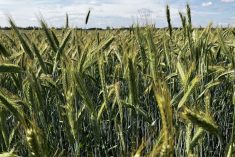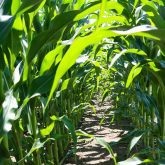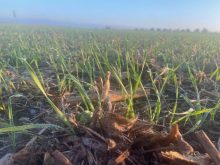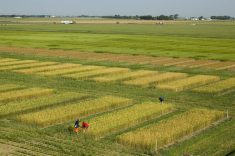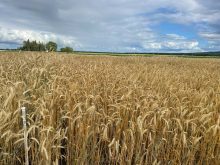GROWTH After falling for years, winter wheat acres are on the rebound in Manitoba and a rebate program is helping
Seeded acres of winter wheat in Manitoba have increased for the second straight year, and that’s welcome news for Alex Griffiths, a crop specialist with Ducks Unlimited Canada.
“It’s been kind of an interesting curve to follow,” Griffiths said. “We had peaks in 2008 and 2013, when there were about 600,000 acres planted in Manitoba. Then, if you fast forward to 2020, that was our low, where there were only 32,000 acres planted.”
In 2021 that rebounded to 55,900 acres, and this year it hit 73,400 acres, according to provincial figures.
Read Also

How much nitrogen can farmers really cut?
Manitoba fertilizer trials look for nitrification inhibitor sweet spot, to lower greenhouse gas emissions and cost without hurting yield.
DUC is interested in seeding acres of winter wheat because ducks, particularly pintail ducks that like sparse cover around their nests, really like to nest in the stuff.
“Back in the early ‘80s, it was recognized that ducks would often nest in crop stubble in the spring,” said Jim Devries, a DUC research scientist.
“They begin nesting around April 15, lay their eggs in crop stubble, and then, of course, tillage or seeding operations at that time of year will destroy those nests.”
Research led to the idea that fall-seeded crops like fall rye or winter wheat could provide more cover for nesting ducks in spring, and the habitat would remain pretty much undisturbed during the nesting season.
However, until recently, there weren’t many varieties that could survive Manitoba’s harsh winters. Once those hardier varieties came on the market, and winter wheat began to catch on, an interesting phenomenon emerged. The survival of nests in winter wheat was higher than anywhere else.
“Even if they nest in a patch of native grassland, their nests hatch at a greater rate in winter wheat,” Devries said.
When the popularity of winter wheat began to ebb after 2013, it was a concern for DUC. In 2020, when acres reached their lowest level in 20 years, the organization started a winter wheat incentive program that offered a $20 per acre rebate (up to $5,000), as well as agronomic support for farmers who were growing winter wheat for the first time or increasing their acres of the crop.
Griffiths says it’s difficult to determine the impact of the program on the recent uptick in winter wheat acres because DUC mainly operates in the western part of the province.
The incentive program mostly focusses on the prairie pothole region, a wide-ranging area of the Prairies that contains thousands of shallow wetlands. In Manitoba, those are limited to the southwest corner of the province.

However, Griffiths says about 25 per cent of all winter wheat acres seeded in Manitoba in 2020 came from farmers taking part in DUC’s incentive program. This year, one third of DUC program participants had never grown winter wheat before, while another third had not grown it for five or more years. That indicates at least some of the increase in acreage was prompted by the program.
For some of those farmers, their reasons for planting winter wheat were clear.
“First and foremost, it was the DUC rebate,” says Ryan Downey, a first-time winter wheat grower who farms with his father near Coulter.
“It also eased up the spring workload. This spring, we had a lot of neighbours that were jealous. A lot were wishing they had done it.”
But while the incentive program is encouraging many to try winter wheat, Griffiths says there is likely a more important factor driving the crop’s recent momentum.
“I think the big thing with the increase in winter wheat lately is that we’ve had a lot of new varieties coming out,” he said. “Wildfire and Gold Rush are some really top-notch ones, and Vortex is another coming out soon.”
The new varieties show excellent results in yield and disease resistance, but Griffiths says the biggest improvement is in winter survival.
“When you plant a crop and it doesn’t make it through the winter, you’re obviously not very happy about it. But when it makes it through the winter four out of five times, that’s pretty dang good. It’s a lot different than what we used to see with those older varieties.”
Nevertheless, there’s a long way to go to reach the 600,000 acres of winter wheat seen in some other years.
“It has been steadily increasing, but we’ve only got a little over a tenth of what it used to be,” Griffiths said. When so few farmers plant the crop, it creates a self-perpetuating cycle.
“For a while, you’d have one guy growing winter wheat within a 20-mile radius,” he said. “It was hard to even source seed if you were thinking about planting it. So it would be nice to have it on a couple more farms and have some more advocates for the crop if possible.”
Anne Kirk, a provincial cereals specialist with Manitoba Agriculture, says there are perceptions and established habits to overcome, one of which is timing.
“[Winter wheat] is great in years where farmers can spread out the harvest a bit,” she said. “But depending on the environmental conditions, you might be harvesting winter wheat and spring wheat at very similar times.”
Farmers might also be reluctant to pull out a seeder at harvest time.
Lingering memories of a bad experience with winter wheat might be another obstacle, but those memories could have been formed when only poorer yielding varieties were available.
“When you look at the Seed Guide, Wildfire is one that is quite popular,” says Kirk. “Over the past number of years of testing, we do see it yielding quite high. Some of those newer, higher-yielding varieties could convince farmers to try winter wheat again.”
Griffiths acknowledges the timing can be tricky, and suggests managing that by seeding on rain days, or in the morning if there has been a heavy dew. For those farmers still reluctant to embrace winter wheat, Griffiths has a final pitch.
“I can give you five good reasons to grow winter wheat,” he said. “Fall seeding saves precious time during the busy spring. The crop is early out of the ground and competitive against weeds, which can help manage herbicide resistance. Early harvest in August means warm, long days that allow the combine to keep rolling. Top it off with consistently high yields and good pricing.”
From the perspective of a conservation scientist like DUC’s Devries, the answer is even simpler.
“There aren’t many win-wins that combine conservation with standard annual cropping practices,” he said. “This is one of them.”





